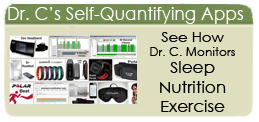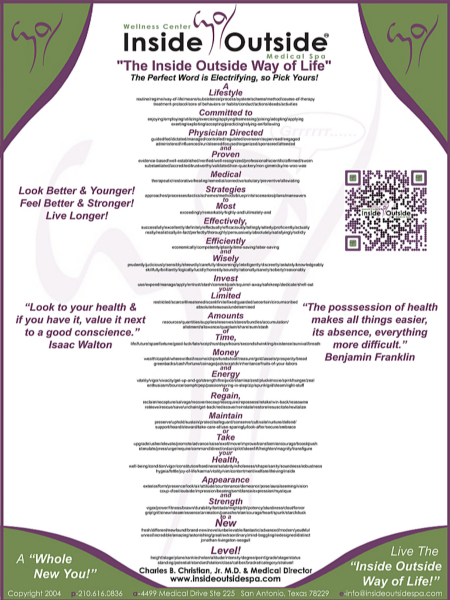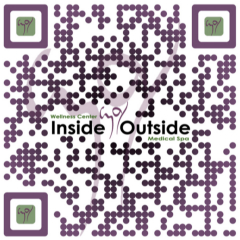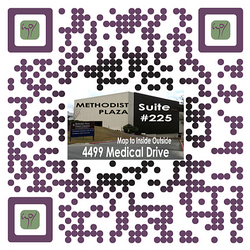
Review of Dr. Christian's Self-Quantifying Utilities
In Life's Great Experiment You are Your Own Guinea Pig
Take Care of the Pig.....

Parameters Quantified
Sleep and Sleep Stages
Exercise Monitoring
Steps and Distance
Nutrition & Calories In
Calories Burned
Heart Rate Variability (HRV) & Stress Levels/Management
Blood Pressure
Weight, Body
Fat % & Lean Mass
GPS Location Monitoring
and Distance Traveled
BlueLight
Suppression & Therapy
Blood, Tissue,
MicroBiome and DNA
|
Most of you know that Dr. Christian likes to measure things. He is a true self-quantifier and technology has allowed him to monitor
his "Health Triad" (Sleep, Nutrition, Exercise) and other
aspects of his health and daily life. All of this has become a habit
for him and it requires a little time to review the data but the logistics
to gather the data are pretty much automated by the technology. His Smartphone is the Android HTC One M9
with the iPhone 5s used for a few apps. Here is how he monitors his
"Inside Outside Way of Life!"
From Dr. Seuss, "The Lorax"
"Unless someone like you cares a whole
awful lot, nothing is going to change, it's not" Once-ler.
Sleep and Sleep Stages:
Dr. Christian was one of the first users of the
Zeo
Headband system when it was introduced in 2009 and he has nearly 9 years of
sleep data gathered by Zeo. Unfortunately the company went
bankrupt in 2013,
but the Zeo still works and there are two 3rd party applications* which allow
viewing of the sleep stage (REM, Deep, Light, Awake intervals) data stored
on a SD card by the bedside unit in the form of 5 minute
(Zeo Data Decoder) and 30 second
(Zeo Sleep Viewer) Hypnograms. Nothing on the market at this time comes close to the Zeo
in terms of measuring sleep stages. He has used the
S+ by ResMed (bedside
device aims a
low power radio wave at the chest which detects breathing) and wrist bands
Garmin VivoSmart,
FitBit One and the
FitBit Blaze
(somehow try measure sleep stages by body movements during the night) to document sleep.
I think these devices are useless for sleep stage measurement and the S+
measures way too much deep sleep. At least some of the devices allow one to start and stop the sleep session so you can get
total duration measured accurately, but they are useless for measuring sleep
stages. A Stopwatch would work just fine
to measure total in bed time. Sleeping heart rate during the
night is reliably measured and documented by a
Polar H10 Chest Strap Heart Rate Monitor which transmits the heart rate to the
Polar Beat Android
app which then sends the data automatically to
flow.polar.com for a nice graphical view and analysis of your heart rate
while sleeping (it is useful to see how low your heart rate gets during
sleep). Dr. Christian was also one of the first users of
Bedditt,
a ribbon like device which is placed under your sheet near your chest. The
device senses ballistic movement of the chest and heart beating and measures
breathing and heart rate. No sleep stages are reliably measured using
Bedditt. Occasionally, he uses
REM Dreamer Pro to try and enhance
Lucid Dreaming.
I am currently evaluating the
Dreem Headband.
I have not seen any improvement in Deep Sleep as promised with this device
as measured by Zeo. We are still waiting for a Zeo
Replacement. Hard to understand why we don't have a good substitute.
The market is begging for this. I understand from the
Quantified Self Forum that
ResMed has the patents and
intellectual property of Zeo. They could create one.
*See
Zeo Raw
Data Library for instructions to use zeo.dat for viewing in the Zeo
Data Decoder (5min) or Zeo Sleeep Viewer (30sec).
You must
update your Zeo bedside unit firmware for it to create an unencrypted
zeo.dat file to use it in these viewers. Resources for doing this can be
found in the Zeo Raw Data Library and Eric Blue's Blog
"Life Beyond Zeo".
Exercise
Monitoring:
For his Hi-Lo
Strength Training Workouts
he routinely wears the Polar
H10
Heart Rate Monitor which works well with
the Android
Polar Beat
App.
Polar Beat syncs the data with their website
flow.polar for storing and viewing in a graphical format.
Steps &
Distance :
These are measured by hip
worn devices
Omron HJ-720IT. In the past I have used the
Fitbit One
and wrist devices
VivoSmart and
Basis Peak
(Discontinued). Recently, I have used the
FitBit Blaze.
There is no doubt that the hip worn devices are more accurate than the wrist
devices. The steps data from Fitbit Blaze are sent to the
FitBit
Dashboard. Fitbit Blaze seems to accurately measure floors climbed also.
Distance is measured by the Omron Device by your Stride Length and there is
a USB upload from the Omron to the
Omron Windows Health Management Software
so you can view weekly, monthly and yearly data easily. Somehow
the other devices measure distance by steps but don't require stride length. I have not tried a
GPS enabled watch like the
FitBit Surge or the Garmin Vivoactive.
Nutrition & Calories In:
Dr.
Christian practices Low Carbohydrate Nutritional Ketosis. He gets ~60%
of his calories from fat, 5-10% carbohydrate and 30-35% protein (~150gm per day) +
alcohol (2-3 oz
Scotch). Protein sources are eggs, fish, suschi, beef (brisket or jerky) and cheese +
Optimum 100% Gold Standard whey protein powder which is supplemented
with
Optimum BCAA +
Optimum Creatine and
Bob's Red Mill Unmodified Potato starch. Half of the
fat calories are from
long chain fatty acids (13-21 carbon fats) and half from
medium chain triglycerides (MCT or 8-12 carbon fats). The MCT come from
Bulletproof Brain Octane
(C-8)
and
Bulletproof XCT Oil (C8 & C10). Calories in is documented using
MyFitnessPal
or lately
Cron-O-Meter. Daily
Weight is monitored by using the
Nokia Body Cardio Scale which integrates with Cron-O-Meter. Blood Glucose
and Ketosis previously were measured by
Precision Xtra finger sticks and the
Ketonix breath analyzer and rarely with
Urine Ketone Strips,
but recently he has used the
KetoMojo
Blood Ketone/Glucose Device as the ketone strips are cheaper.
Recently, he has
been using the
Accu-Chek Aviva Connect Glucose Meter which automatically sends
results to your
iOs smartphone app and then to a online database.
He also periodically uses the
A1C Now+ home test. He has recently been experimenting with Ketone
Esters by
KetoneAid and has the Ketone Ester made by
HVMN on
order. He will use these for his strength training workouts.
These products may not be as useful for anaerobic strength training.
Calories Burned:
These are
measured by the
FitBit Blaze
which measures calories burned by heart rate and steps. There is no
good way to measure Anaerobic Calories burned during Hi-Lo Strength
Training. The Polar H10 and Polar Beat software try to give a calorie
burn during the
Hi-Lo
Strength Training based on heart rate. The simple fact is that
it is hard to get a real good measurement of calories burned with activity
outside of a research setting.
We know that for fat loss the most important thing is probaly calorie reduction.
Exercise does burn some calories but the most important thing is that
exercise should help you maintain muscle while losing fat and keep your
metabolic rate from slowing with reduced calorie intake.
Heart Rate Variability (HRV)
& Stress Levels/Management:
The Polar H10 chest strap heart rate measurement is recorded real time
via Bluetooth by Android HRV Apps
HRVxt Pro,
Elite HRV
and
HRV Expert.
HRVxt Pro creates a RR interval data file (*.txt) during sleep, exercise or
controlled breathing. The RR interval data file from HRVxt Pro can further be analyzed using the
sophisticated Windows
program Kubios
HRV. Elite HRV and HRV Expert are used immediately after awakening to assess AM
Readiness and Stress Levels based on their HRV algorithms. HRV is also calculated
occasionally
during five minute
controlled breathing meditative sessions with
the
HeartMath emWave Pro Windows application. The HeartMath program uses an
ear or finger pulse sensor for its RR (actually PP) interval measurement.
BLE HRM & HRV Recorder is another nice HRV program which is occasionally
used with the Polar H10 chest strap. SweatBeat
HRV is an iOS software app which works with several chest straps. RR interval data files created by HRVxt Pro are
managed by
ES File Explorer which allows easy transfer from your smartphone to your
computer using
Dropbox.
The process can be automated using
Dropsync. Occasionally we use a
BioRadio Wireless Physiologic Monitor sensing device worn on the hip
with 3 EKG electrodes to capture real time EKG and heart rate. The data from
the BioRadio is sent via Bluetooth to
Biocapure Software which creates a file that is analyzed with the
Vivosense HRV Module. I'm still trying to convince myself that
serial HRV
measurements
via Elite HRV, HRV Expert or Sweetbeat are useful for assessing recovery from workouts or
sports training.
Blood Pressure:
The
Omron BP786 is a nice desktop self inflating Bluetooth device which
sends data to the
Omron Wellness Android App and is very easy to use. There is
not a Omron website however to store the data. The
Qardio is a device which connects with Bluetooth 4.0 (iOS and
Android) and compares very well to the Omron device. I missed out on the
Scanadu
Scout Indego promotion, so I can't comment about it. If anyone has one
for sale I would be interested. Contact at
cbcmd@sbcgloblal.net.
Weight, Body Fat %, Lean Mass
and Visceral Fat:
Measurements
on our stand up medical scale,
Tanita TBF 300A Bioimpedance
scale and
DXA Body Composition are done often to document changes in these
parameters. Scans are compared by creating PowerPoint slides of the scan
color images and with our
Proprietary DXA Body Composition Comparison Tool Utility. The DXA
Scanner also measures Visceral Fat Tissue.
GPS Location Monitoring and Distance
Traveled:
Since Dr. Christian
does not run or cycle he has not had any need for GPS tracking of a route or
distance. The Polar Beat App
can
be configured to track your route during driving using GPS
with or without the Polar H10 Chest strap and does a very accurate
measurement documenting
distance and route traveled. Dr. Christian
has also used
FollowMee which will track any smartphone location and it's route very
accurately. Every street and turn is tracked and the free version stores 7
days of data which is viewed on the
FollowMee
Website dashboard. The Deluxe version of FollowMee can be configured to automatically
track your route when it senses your car/phone moving.
GPS/Location data needs to be enabled on your smartphone for this to work and
naturally uses your up monthly data quota.
BlueLight Suppression and Therapy:
f.lux
is used on his laptops for blue light suppression at night and
Twilight is used on Smartphones. The
Phillips goLite Blue Light Therapy device is used daily on awakening to
reset his circadian
rhythm.
Solar Shield Fits-Over Sunglasses that block blue light are worn while
driving home late in the day.
Blood, Tissue, MicroBiome &
DNA: Dr.
Christian has had
DNA
testing from Ancestry.com and
23andme,
Telomere Length Testing and longevity genotyping,
Omega 3 Fat Testing
(AA/EPA Ratio) and microbiome analysis from
uBiome and
the
American Gut Project. Every year or two routine lab and hormonal
testing usually with
Quest Diagnostic Labs. Check out his
American Gut Sample and his
AA/EPA results.
|


This is a nice forum for people like me!!
There are numerous short videos available. One
I especially enjoyed was
"Effects of a Year in Ketosis by Dr. Jim Carter"
Nice review of benefits and challenges of
Nutritional Ketosis.
Other Fine Services & Products t
Premium Services & Products to
Complement Your Quest
for a New Level of Health, Strength & Appearance!
You will be Exercising Less and
Eating More and learn to live
"The Inside Outside Way of Life!"
The
Poster! "The Inside Outside Way of Life"






Scan Inside Outside on Your Mobile Phone!!

Custom QR
Codes made by
QRlicious!
Hi-Lo Strength Training,
Zone/Paleo/Bulk/Lo-Carb/Ketosis Nutrition,
DXA Bone Density,
DXA Body Composition
Botox,
Diamond Microdermabrasion,
VI
Superficial Peel,
Rejuvapen
Treatments
The Best of Each In San Antonio!





















Methodist Plaza
4499 Medical Drive #225
San Antonio, Texas 78229
Call 210.616.0836 to Schedule Your
Free Consultation
Visit us
at Facebook! Become a Fan!

Scan a
Google
Map to Inside Outside

Custom QR
Codes made by
QRlicious!
Questions/Comments/Suggestions/Complaints
Please Email Us
iocontact@insideoutsidespa.com or
Use Our
Contact Form
Sign up
for our Newsletter!
Return to
Inside Outside Home Page
